
* In the postwar period, the US Navy decided to obtain a carrier-based nuclear strike capability, with the effort leading to the twin-engine Douglas "A3D Skywarrior" jet bomber. The A3D was an excellent aircraft, being put to a range of uses including the reconnaissance, electronic warfare, tanker, and trainer missions, serving with distinction during the Vietnam War and later.
The US Air Force acquired a derivative, the "B-66", which also served with distinction in bomber, reconnaissance, and electronic warfare roles. This document provides a history and description of the A3D and B-66 -- as well as of the A3D's predecessor in service, the North American "AJ Savage". A list of illustrations credits is included at the end.
* At the end of World War II, the US Navy realized the importance of the nuclear strike mission, and felt the need to acquire a nuclear strike capability to improve the effectiveness of the service and maintain its political influence. The Navy would eventually acquire an extremely effective strategic nuclear deterrent force in the form of their fleet ballistic missile submarines, but in the late 1940s such a concept was almost science fiction. In the short term, carrier-based aircraft would have to do the job.
Nuclear munitions of the era were bulky and required a large aircraft to carry them. The Navy improvised a carrier-based nuclear strike system by modifying the Lockheed P2V Neptune twin-prop ocean patrol aircraft for carrier take-off using jet assisted take-off (JATO) rocket boosters, with initial take-off tests in 1948. The Neptune couldn't land on a carrier, so the crew either had to make their way to a friendly land base after a strike, or ditch in the sea near a US Navy vessel.
That was obviously not a very practical scheme -- the primary motivation behind it was almost certainly political -- but only days after the atomic bombings of Japan in August 1945, the Navy had begun a competition to acquire a carrier-based nuclear bomber aircraft, leading to award of a contract to the North American company in June 1946 for three prototypes of the "NA-146". The initial NA-146 prototype, designated the "XAJ-1 Savage", performed its initial flight on 3 July 1948, with test pilot Bob Chilton at the controls.
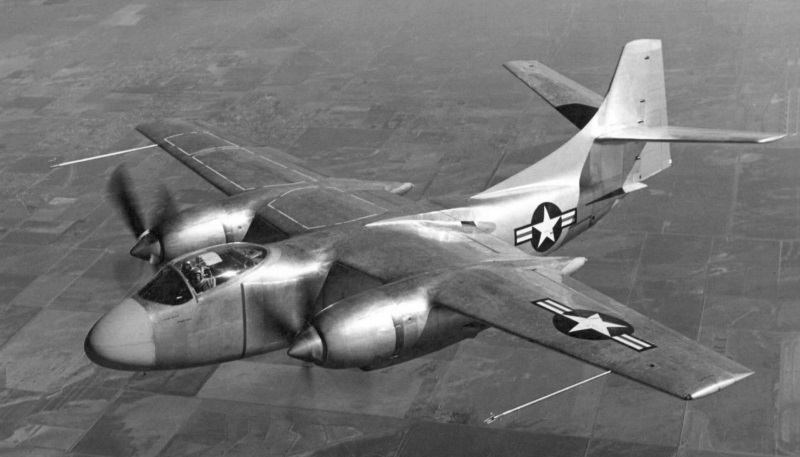
There were difficulties with the flight test program, both the second and third prototypes being lost in accidents, but the aircraft proved satisfactory. The prototypes were followed by 55 production "AJ-1s", with initial deliveries to the Navy in September 1949.
* The AJ-1 was powered by twin Pratt & Whitney (P&W) R2800-44W Double Wasp two-row 18-cylinder radial engines providing 1,790 kW (2,400 HP) each, with one mounted on each wing and driving a four-bladed propeller, plus an Allison J33 centrifugal-flow turbojet providing 20.46 kN (2,090 kgp / 4,600 lbf) thrust in the tail. The jet engine intake was on the back of the aircraft between the wings, featuring a door that closed when the jet engine wasn't in use, reducing drag; the exhaust was under the tail. All three engines used the same type of aviation gas fuel. The twin radials were used for cruise, with the jet engine kicked in for take-offs and combat boost speed. JATO units could also be attached.
The AJ-1 was of all-metal construction, with tricycle landing gear, all retracting backward, with single-wheel nose gear and double-wheel main gear in the engine nacelles. It had high-mounted straight wings that folded up under hydraulic control outboard of the engines, and featured wingtip fuel tanks. It is unclear if the wingtip tanks could be removed; the only pictures of Savages without them are of the prototypes. The tailfin had a large forward fillet, with the tailplane mounted at mid-height on the tailfin; the tailplane folded to the right just above the tailplane for carrier hangar storage. For some aerodynamic reason, there was a strake airfoil on each side of the tail. There was a stinger-type arresting hook under the tail.
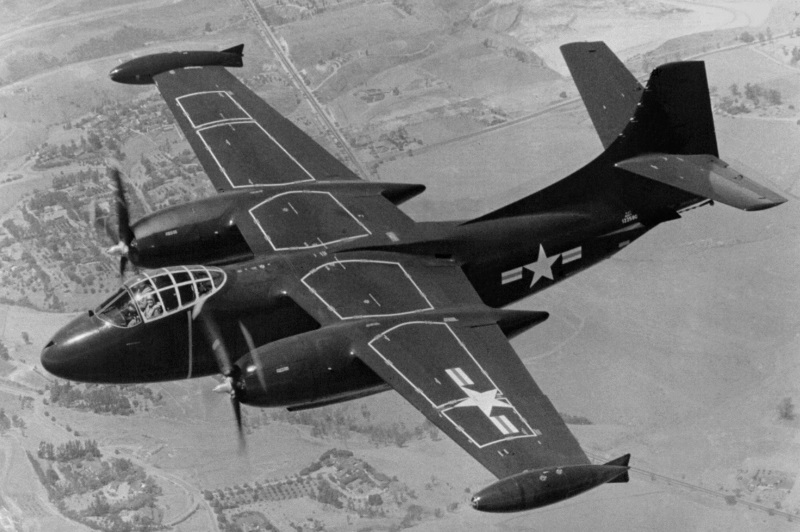
There were three crew -- pilot, copilot, and navigator / bombardier -- sitting under a greenhouse-style framed all-round vision canopy, with entry through a door on the right side of the fuselage. There was a window in the canopy that could be popped open for emergency escape. Up to 5,440 kilograms (12,000 pounds) of munitions were carried in a internal bomb bay; the bomb bay was pressurized and climate-conditioned since the nuclear munitions of the day required a bit of babying. The Savage had no defensive armament, relying on speed for defense. The XAJ-1s had differed from the production machines in being fitted with less powerful R-2800-44 radials and carrying two crew under a sliding clear-vision canopy.
___________________________________________________________________
NORTH AMERICAN AJ-1 SAVAGE:
___________________________________________________________________
wingspan:
21.8 meters (71 feet 5 inches)
wing area:
78 sq_meters (836 sq_feet)
length:
19.2 meters (63 feet 1 inch)
height:
6.2 meters (20 feet 5 inches)
empty weight:
12,500 kilograms (27,560 pounds)
typical take-off weight:
21,365 kilograms (47,000 pounds)
max take-off weight:
23,160 kilograms (50,955 pounds)
maximum speed (all three engines)
760 KPH (470 MPH / 410 KT)
service ceiling:
13,100 meters (43,000 feet)
range:
2,620 kilometers (1,630 miles / 1,415 NMI)
___________________________________________________________________
The AJ-1 was followed by a reconnaissance variant, originally designated the "AJ-1P", but finally designated "AJ-2P". A production AJ-1 was modified as the prototype. The primary change in the AJ-2P was a suite of downward-looking and side-looking cameras in the rear of what had been the bomb bay, plus a modified nose that eliminated the bombing radar in favor of a forward-looking camera and gave the AJ-2P a distinctive stepped nose. A load of photoflash flares could be carried in the remaining forward section of the bomb bay for night reconnaissance missions.
The AJ-2P also featured uprated R-2800-48 engines with 1,865 kW (2,500 HP) each, and an uprated J33-A-10 turbojet with 21.4 kN (2,175 kgp / 4,800 lbf) thrust. The dihedral tailplane was replaced with a flat tailplane, the tailfin height was increased by about 30 centimeters (1 foot), and later production added a fourth crewmember as a dedicated photo tech. The first AJ-2P flew on 6 March 1952, with 30 built. Incidentally, along with photographic missions for the Navy, the AJ-2Ps also performed some photo missions for the Army, as well as for the US Geodetic Survey and the US Department of Agriculture.
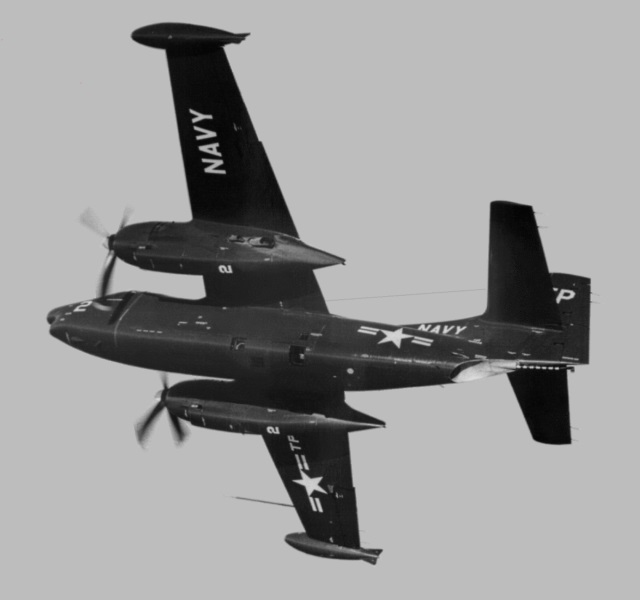
The AJ-2P led to an improved attack version, the "AJ-2", with the new engines, updated tail, and other small improvements from the AJ-2P. The first AJ-2 performed its initial flight on 19 February 1953 and 55 were built; 42 AJ-1s were updated to a "near AJ-2" specification, with the new tail and engines. A total of 143 Savages was built, including prototypes.
* Early on, Savages were painted all dark blue as was Navy practice at the time, but they later were painted in new-standard gull gray topside and white on the bottom. The Savage apparently was on the complicated side and hard to maintain, and since the Navy was not used to operating such a big aircraft on an aircraft carrier, the accident rate was unpleasantly high.
The unusual "tri-motor" engine configuration -- "two turning, one burning" -- was said to be a source of amusement for Savage aircrews, who liked to fly alongside non-Navy aircraft and then shut down both piston engines. There was a tale of one pilot who performed a landing on a ground base and forgot to shut down the turbojet, to plow through the fence at the end of the runway. However, a turbojet flameout during a carrier take-off with a heavily-laden aircraft was no joke, something nobody wanted to experience twice -- if they survived it the first time.
The Savage's first-line service life was brief, with roughly 50 survivors converted to single-point hose-&-drogue inflight refueling tankers in the last half of the 1950s. It appears the jet engine was yanked; these machines were not given a new designation.
Early on in the Savage program, there was consideration of using the Savage as an unpiloted "cruise missile" to deliver a nuclear weapon, with the fact that the mission was one-way permitting very long range. The robot Savage was given the designation of "SSM-N-4 Taurus" and was to be guided part of the way by a piloted control aircraft. However, the idea was judged impractical and the Taurus was canceled in 1948. Another effort to come up with an "AJ-3 Savage" with shorter wings and fuselage to make it easier to deal with on a carrier deck also came to nothing.
Two prototypes of the "XA2J-1 Super Savage", with twin Allison XT40-A-6 turboprops and no turbojet, were flown, with the initial flight of the first prototype on 4 January 1952. Along with the different engine arrangement, it had a swept tailfin, with the tailplane mounted at the base of the tailfin instead of the middle, and armament of twin 20 millimeter cannon in a tail turret, though the cannon were never actually installed. The XT40 was a "twin-pac" engine, with twin turboprop in each nacelle driving a contrarotating prop system with dual three-bladed props; one turboprop in the nacelle could be shut down, with the remaining turboprop used for cruise. The XT40 was unreliable, and pure jet aircraft seemed like the better deal anyway. The second prototype was used as an engine test bed, but that was the end of it.

* When the US military adopted a uniform designation scheme in 1962, the few AJ-1, AJ-2, and AJ-2P machines lingering in service were redesignated "A-2A", "A-2B", A-2P" respectively. They were apparently only in use as ground training machines by that time, with the last being finally withdrawn in 1964. The US Navy was the sole military user of the Savage, none ever being exported, but there were other US users:
The Savage never got into a real war. Some AJ-2Ps may have performed spy flight incursions into Red airspace, but if so the records say little about the matter. A few Savages survive as static displays.
BACK_TO_TOP* The Savage didn't remain in frontline service long because it was seen as an interim solution from the day it performed its first flight, the Navy having already put the wheels in motion for a much better successor.
In 1947, the US Navy, issued a request for a carrier-based strategic nuclear bomber, capable of carrying a 4,500-kilogram (10,000-pound) nuclear weapon to an operational radius of 3,700 kilometers (2,000 NMI), with the aircraft featuring a loaded weight of no more than 45,000 kilograms (100,000 pounds). A number of companies submitted proposals. The Douglas company's proposal was designed by a team under the well-known Ed Heinemann and defined a sleek swept-wing aircraft powered by two Westinghouse J40 engines, one in a nacelle on a pylon under each wing. The Navy had been lobbying for a "supercarrier", the USS UNITED STATES, to support nuclear strike aircraft, but the Navy and Air Force were engaged in a bitter struggle at the time over who had the strategic nuclear mission. Heinemann wisely felt it unsafe to assume that the UNITED STATES would actually be built; he insisted that the gross weight of the aircraft be no more than 31,750 kilograms (70,000 pounds), so it could operate off of existing carriers.
Both Douglas and Curtiss were awarded preliminary contracts to refine their designs. The two submissions were examined, with the result that the Navy awarded Douglas a contract for two prototypes of the "XA3D-1", as it was designated, on 31 March 1949. The UNITED STATES was canceled in April, validating Heinemann's judgement. The XA3D-1s were fitted with Westinghouse XJ40-WE-3 engines with 31.1 kN (3,175 kgp / 7,000 lbf) thrust each. The first prototype made its initial flight on 28 October 1952.
Although the Navy had been banking heavily on the Westinghouse J40 for the service's new generation of jet aircraft, the J40 program was terminally "snakebitten", the engine would never go into full production, and in fact Westinghouse would soon drop out of the jet engine business. The J40-WE-12 being proposed for the production machine wasn't powerful enough anyway, having only 33.4 kN (3,400 kgp / 7,500 lbf) thrust; after discussions with the Navy, Douglas engineers modified the design for the P&W J57 turbojet, with both prototypes refitted with J57-P-1 engines.
The single "YA3D-1" production prototype was fitted from the outset with J57-P-1 engines. The first production "A3D-1 Skywarrior" performed its initial flight on 16 February 1953, with the type going into service with Navy squadron VAH-1 at Naval Air Station (NAS) Jacksonville in Florida in March 1956, the Skywarrior performing its first sea cruise later in the year.
BACK_TO_TOP* The basic configuration of the Skywarrior did not change greatly over its production lifetime -- though there would be a considerable range of modifications -- and the A3D-1 provides a baseline for the family. The A3D-1 was of all-metal construction, mostly of aircraft aluminum, with a high-wing configuration and all-swept flight surfaces, powered by twin P&W J57 turbojets, and fitted with tricycle landing gear.
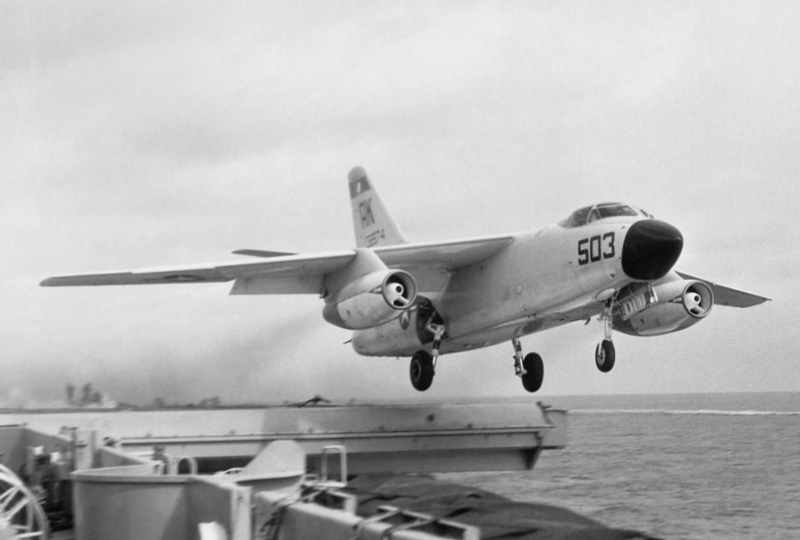
The wings had a sweep of 36 degrees at quarter-chord plus a slight anhedral droop; the outer third of the wings folded up hydraulically to reduce the aircraft's footprint for carrier handling and stowage. The wings featured automatic leading-edge flaps outboard of the engines, while the trailing edge was fitted with one-piece flaps out to the wing fold and an aileron outside of the wing fold. The tailplane was mounted low on the tailfin; the tailfin above the tailplane folded to the right for stowage.
The engine fit was initially the J57-P-1, with 44.5 kN (4,535 kgp / 10,000 lbf) thrust, with production flowing to the J57-P-6A and then J57-P-6B, with the same thrust but technical improvements -- presumably early production aircraft were updated to improved engines as they became available. Six JATO bottles could be attached to each side of the rear fuselage, for a total of twelve JATO units, for heavily-laden take-offs.
There were self-sealing fuel tanks fore and aft of the bomb bay, and in the wings out to the wing fold. All the landing gear assemblies had a single wheel, with the nose gear retracting forward and the main gear tucking into the fuselage. There was a large hydraulically-operated airbrake on each side of the rear fuselage, a stinger-type arresting hook under the tail, and an extensible bumper wheel forward of the arresting hook to prevent tailstrikes on take-off or landing. A3D-1s were refitted in service with a brake chute for setting down on land airstrips.
There were three crew -- pilot, bombardier/copilot/navigator, and gunner -- in a pressurized cockpit under a glazed framed canopy. The pilot and bombardier-navigator sat side-by-side, while the gunner faced backwards. The crew got into the aircraft through a hatch just aft of the nosewheel. There was a sliding hatch at the back of the top of the canopy, which was opened to permit the crew to check the aircraft during pre-flight and scope out the carrier deck environment; the hatch was left open during take-offs and landings.
There were no ejection seats, the crew entry hatch instead being used as an escape chute. The ejection seats were left out to save weight, the assumption being that the A3D would generally operate at high altitude. The lack of ejection seats was not appreciated by aircrews since it ensured that the likelihood of survival in a low-level accident was poor, and the "A3D" was nicknamed "All 3 Dead".
Defensive armament consisted of twin 20-millimeter cannons in a remote-controlled tail turret, with a fire-control radar in a radome blister at the base of the tailfin. The gunner operated the cannon from the forward cockpit. Offensive warload was up to 5,440 kilograms (12,000 pounds), all munitions being carried in the bomb bay. A spoiler popped down in front of the bomb bay when it was open to reduce buffeting, and prevent stores from hanging up. There was an AN/ASB-1A bombing radar system in the nose.
___________________________________________________________________
DOUGLAS A3D-1 ("WHALE"):
___________________________________________________________________
wingspan:
22.1 meters (76 feet 6 inches)
wing area:
72.4 sq_meters (779 sq_feet)
length:
23.27 meters (76 feet 4 inches)
height:
6.95 meters (22 feet 10 inches)
empty weight:
16,280 kilograms (35,900 pounds)
normal loaded weight:
27,325 kilograms (60,250 pounds)
max take-off weight:
31,745 kilograms (70,000 pounds)
maximum speed:
980 KPH (610 MPH / 530 KT)
cruise speed:
840 KPH (520 MPH / 450 KT)
service ceiling:
11,900 meters (39,000 feet)
range:
3,350 kilometers (2,080 MI / 1,810 NMI)
___________________________________________________________________
The prototypes visibly differed from the A3D-1 in being initially fitted with the Westinghouse J40 engines, in distinctly longer nacelles with sloped engine inlets. The prototypes also had a canopy with considerably less glazing and poorer field of view, along with a countermeasures systems antenna fairing on the top of the tailfin. It appears the fintip antenna fairing was retained in early A3D-1 production, but it was eventually deleted in service.
* A total of 50 A3D-1s was built in all, including the YA3D-1 evaluation machine. The aircraft was the biggest the Navy had ever operated to that time off a carrier deck, and it was appropriately nicknamed the "Whale". It seems unlikely this meant any dislike for its looks; the A3D was, despite its boxy fuselage, a clean, straightforward design. Early on, A3Ds were painted old Navy standard dark blue overall, but quickly acquired the new standard colors of gull gray topside and white underneath, which would be the Skywarrior's livery for most of its career -- if with exceptions.
One of the A3D-1s was modified by Douglas as the effective prototype of a photo-reconnaissance variant of the Skywarrior, this modified machine being designated the "YA3D-1P". It could carry up to 12 vertical and oblique film cameras in a pressurized compartment in the forward bomb bay, with a store of photoflash flares for night observations in the rear bomb bay. The YA3D-1P retained the tail cannon, but the gunner took on the auxiliary job of photo tech and could access the cameras in flight if need be.
Five more A3D-1s were modified by Douglas as electronic warfare (EW) aircraft. They were easily recognized by "cheek" fairings on either side of the forward fuselage, as well as a ventral canoe fairing and a fairing on top of the tailfin, and carried a suite of electronic intelligence (ELINT) gear, operated by four EW operators (EWOs, sometimes nicknamed "ravens" or "crows" for some obscure reason) in a pressurized capsule in the bomb bay. These aircraft were apparently built with tail guns, but the cannon were eventually yanked and replaced by EW gear. The first of the five aircraft was a prototype, designated "YA3D-1Q", while the other four were designated "A3D-1Q".
BACK_TO_TOP* The A3D-1 was quickly replaced in production by an improved model, originally to be designated the "A3D-1B" but actually rolled out as the "A3D-2". The primary changes were fit of more powerful J57-P-10 turbojets with 55.2 kN (5,625 kgp / 12,400 lbf) thrust each, plus a stronger airframe and a revised bomb bay that allowed it to carry a wider range of stores, including naval mines. Empty weight increased to 17,875 kilograms (39,410 pounds), with maximum take-off weight increased to 37,200 kilograms (82,000 pounds). There were marginal improvements in speed and ceiling, plus it appears a noticeable increase in range, presumably due to better engine specific fuel consumption.
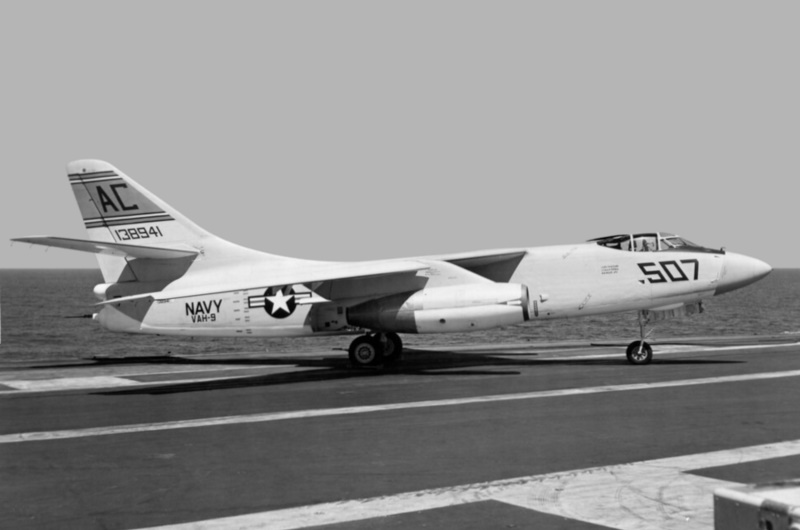
Later production machines were enhanced by adding leading-edge flaps on the wings inboard of the engines, complementing the existing outboard flaps, and fitting a fixed hose-&-drogue refueling probe along the left side of the nose. Provision was also added for plugging a single-point hose-&-drogue tanker kit into the bomb bay, with the kit providing storage for 4,925 liters (1,300 US gallons) of fuel.
Final production machines were fitted with a new AN/ASB-7 bombing-navigation system, replacing the old AN/ASB-1A and featuring a distinctive flat panel on the front of the nose. Since in practice the tail guns of Skywarriors in service had usually been yanked -- leaving the aircraft with a somewhat castrated appearance -- in favor of electronic countermeasures (ECM) gear, these machines were fitted with a clean "dovetail" fairing for the ECM systems, with the gunner becoming a countermeasures system operator. Photos hint that a handy personal baggage compartment with a hinge-up door was installed in the tail along with the dovetail fairing. Earlier production A3D-2s in service were generally updated to late production spec.
A total of 164 A3D-2s was built, with the variant entering operational service in 1957 with US Navy heavy attack squadron VAH-2. At its peak, the A3D-2 equipped eight heavy attack squadrons on the carriers ESSEX and MIDWAY.

* Along with the A3D-2 bombers, a number of A3D-2 subvariants were built as new production machines:
* The A3D-2Ts were the last new production Skywarriors built, the final machine being rolled out in January 1961, for a total production of 283 A3Ds of all types built. When the US military consolidated aircraft designation schemes in September 1962, Skywarrior variants were redesignated as follows:
By that time, most of the original A3D-1 / A-3A Skywarriors had been relegated to training duties, being redesignated "TA-3A".
* After the end of Skywarrior production, several new variants were created by modification of existing stock:
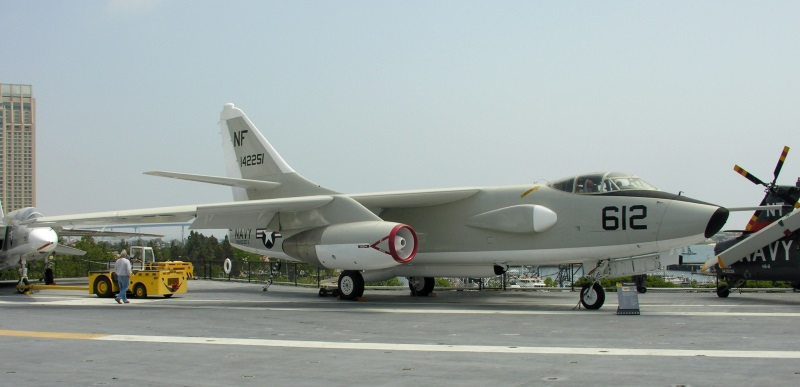
Roughly a half dozen RA-3B (A3D-2P) machines were used for trials of various sorts, sometimes being designated "NRA-3B" for the task. The following table summarizes the Skywarrior variants and their quantities: Roughly a half dozen RA-3B (A3D-2P) machines were used for trials of various sorts, sometimes being designated "NRA-3B" for the task. The following list summarizes the Skywarrior variants and their quantities:
That gives 283 Skywarriors built in all.
BACK_TO_TOP* By 1957, the Skywarrior was in full Navy service. The aircraft was big and demanding to operate off a carrier deck, but its performance was excellent by the standards of the time. Early on, the A3D-2 set a number of records, most significantly a New York to Los Angeles trip in 5 hours 12 minutes on 21 March 1957. The A3D could actually break Mach 1 in a dive, but it wasn't a good idea to try it because the controls would freeze up.
The Whale never performed a nuclear strike of course, but it was used during the early phases of the Vietnam War for conventional bombing raids, performing attacks against lightly-defended targets in 1965 and 1966, with mining missions also performed to March 1967. The decision was made in 1967 that the Skywarrior was too vulnerable to adversary anti-aircraft defenses in attacks on North Vietnam; the Navy concluded that the Grumman A-6 Intruder was better suited to that job. There were experiments with using the Whale for tactical bombing in South Vietnam that proved surprisingly effective, but the judgement was that there were also better tools for that job.
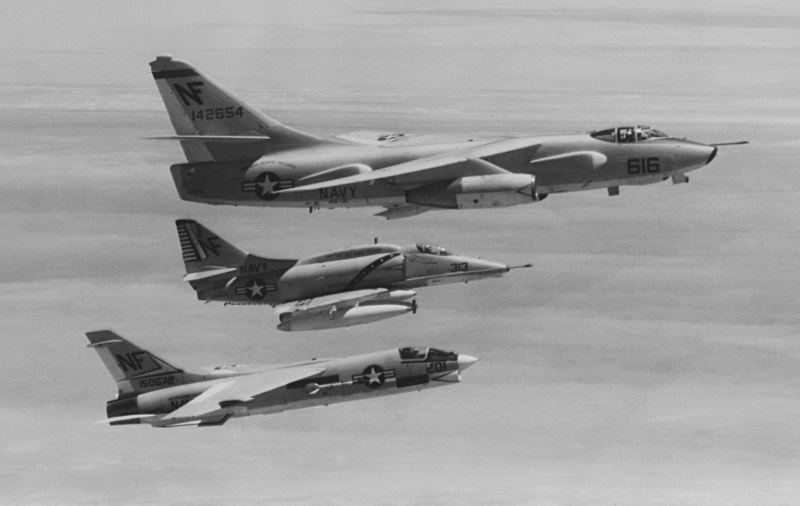
RA-3Bs did fly night reconnaissance missions over North Vietnam, with four lost to enemy air defenses, while EA-3Bs kept track of North Vietnamese radars and communications networks. Its primary contribution to the war was as a tanker, however, with KA-3Bs and EKA-3Bs credited with saving hundreds of shot-up aircraft -- some of which had holed fuel tanks and were kept in the air by continuous refueling until they could make a carrier landing. Late in the conflict, the Whale was generally replaced by the Grumman KA-6D Intruder in the tanker role and the Grumman EA-6B Prowler in the EW role, with Skywarriors turned over to the Naval Reserves.
The Whale survived in a gradually drawn-down fashion after the war in the tanker, EW, VIP transport, and (in the form of the ERA-3B) electronic aggressor roles, though these machines were getting somewhat elderly. In the late 1980s, one old-timer EA-3B was stenciled: HANDLE WITH CARE, ON LOAN FROM THE SMITHSONIAN INSTITUTION. EA-3Bs survived long enough to participate in the first Gulf War in 1991, though the Skywarrior was out of Navy service by September 1991.
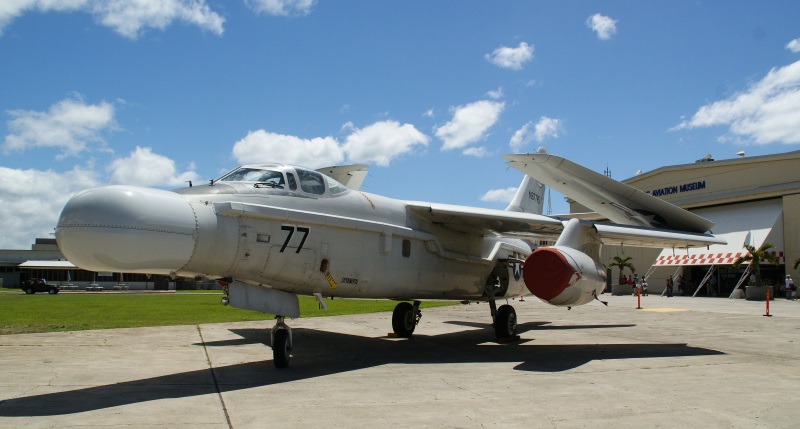
The US Navy was the only military user; no Skywarriors were exported. However, even from the early 1960s, numbers of Whales had been bailed to civilian contractors -- most significantly Hughes and Raytheon -- as test and trials platforms, with these machines often featuring "nose jobs", with radomes tacked on to evaluate new radars. Hughes and Raytheon eventually merged, and at last notice a handful of Raytheon Skywarriors were still flying, and making the occasional flyby at airshows.
BACK_TO_TOP* After the outbreak of the Korean War, the US Air Force (USAF) began to cast around to find a jet-powered replacement for the piston-powered Douglas B-26 Invader, then playing a prominent role in that conflict. In the summer of 1951, the Air Force issued a requirement for a jet-powered tactical bomber and reconnaissance aircraft. Four companies submitted proposals:
At the end of November 1951, the Douglas proposal was announced as the winner, with detailed specifications issued in early 1952 for the "B-66", as it was designated. The B-66 was to be fast and maneuverable, capable of carrying a payload of 4,500 kilograms (10,000 pounds) of conventional bombs, nuclear bombs, or reconnaissance kit over an operational radius of 1,850 kilometers (1,000 nautical miles). The aircraft would feature defensive armament and ECM, would be easy to maintain, and would be able to operate from rough airstrips.
The USAF planned to acquire a production "RB-66B" or "Model 1329" reconnaissance version and a "B-66B" or "Model 1327A" bomber version, with the RB-66B seen as the higher priority. The original expectation was that there would be few changes from the Navy Skywarrior, and so no "XB-66" prototypes were ordered; a batch of five pre-production "RB-66A" or "Model 1326" machines would be adequate. Formal development went ahead under a team at the Douglas Long Beach, California plant led by John C. Buckwalter.
A production contract was issued in December 1952. By that time, the number of changes to the Air Force machine had resulted in an aircraft that was clearly different from the Navy Skywarrior. The overall configuration of the two machines remained similar, the B-66 retaining the general layout, landing gear arrangement, tail turret, and three crew of the A3D. The initial changes from the Navy Skywarrior included the obvious measures of eliminating wing fold, arresting hook, and catapult attachment -- but further changes were more drastic. Although the Skywarrior wasn't fitted with ejection seats, the B-66 was intended for low-altitude operation from the outset, and since it didn't have to operate from a carrier, it didn't have as low a weight limit; as a result, the B-66 was fitted with upward-firing ejection seats. That required a complete redesign of the cockpit canopy to provide ejection hatches. The cockpit layout was also revised, with the pilot sitting forward in the middle, and the navigator and gunner / reconnaissance systems operator sitting side-by-side behind him.
The low-altitude requirement also meant a stronger airframe and wings. The wing layout was changed, with greater area, thinner cross-section, and new flaps and ailerons. The wing angle of incidence was changed as well. The B-66 had a larger radar antenna than the A3D, demanding modifications to the nose; larger tires had to be fitted to meet the rough-field requirement; and changes were made to hydraulic and fuel systems. One big change was with the engines. The Navy Skywarrior, as mentioned, was to be powered by the P&W J57. The Air Force thought of using the J57 as well, but there were worries about availability, and the General Electric / Allison J71 was chosen instead.

A mockup was ready for inspection at Douglas in June 1952. Air Force brass were happy with it, but recommended beefing up the landing gear. Development went forward and the first of the five pre-production RB-66As performed its initial flight on 28 June 1954, with George R. Jansen at the controls. The prototype was powered by twin Allison YJ71-A-9 engines, providing 42.6 kN (4,340 kgp / 9,570 lbf) thrust each. Trials revealed some handling problems, buggy landing gear doors, and poor field of view from the cockpit.
The other four RB-66As were in the flight test program by the end of 1954. Flight tests didn't go well at first, with difficulties with system reliability, wing vibration, and a nasty tendency to "pitch up" without warning. The Air Force considered canceling the program, but progress was made in fixing the problems, though the total planned buy was cut back. The first production RB-66B performed its initial flight in March 1955, with the first service deliveries in February 1956. The type was given the official name of "Destroyer". None of the pre-production RB-66As went into Air Force service, though one was handed off to General Electric (GE) as an engine trials platform.
BACK_TO_TOP* A total of 145 RB-66Bs and 72 B-66Bs was built, with the aircraft going into widespread service with the USAF Tactical Air Command (TAC) during 1956. The RB-66B became TAC's primary night reconnaissance asset.
The two variants were very similar except for payload. The RB-66B featured a film camera payload in the belly and could carry photoflash bombs in its bomb bay, while the B-66B could carry up to 6,800 kilograms (15,000 pounds) of munitions in its bomb bay. Most production was powered by Allison J71-A-11 turbojets with 45.8 kN (4,670 kgp / 10,300 lbf) thrust each, though late production was fitted with J71-A-13 engines, providing the same thrust but offering a number of technical improvements; older machines were refitted with the J71-A-13 as well. Both variants were fitted with inflight refueling probes.

The B-66B was designed for a higher maximum take-off weight, 3,628 kilograms (8,000 pounds) more than the RB-66B. The bomb bay was lengthened and the capacity of the aft fuselage tanks was increased. A stores pylon was added outboard on each wing to handle a 1,895-liter (500 US gallon) external tank, and a K-5 bombing system was fitted.
___________________________________________________________________
DOUGLAS B-66B DESTROYER:
___________________________________________________________________
wingspan:
22.1 meters (72 feet 6 inches)
wing area:
72.5 sq_meters (780 sq_feet)
length:
22.91 meters (75 feet 2 inches)
height:
7.19 meters (23 feet 7 inches)
empty weight:
19,295 kilograms (42,540 pounds)
typical take-off weight:
26,215 kilograms (57,800 pounds)
max take-off weight:
37,650 kilograms (83,000 pounds)
maximum speed:
1,000 KPH (620 MPH / 540 KT)
service ceiling:
12,000 meters (39,400 feet)
range:
3,975 kilometers (2,470 miles / 2,150 NMI)
___________________________________________________________________
* The B-66 had been designed for the tactical reconnaissance and bombing roles, but they weren't the jobs the machine ended up doing, eventually finding its niche in the EW mission.
The "RB-66C" was the only purpose-built B-66 EW variant. It carried ELINT gear to spot adversary radars and other "emitters", as well as ECM gear including radio frequency (RF) jammers and chaff pods, with a chaff pod fitted under the wing outboard of each engine. Jammer pods were fitted to the wingtips. There were seven crew -- the traditional pilot, navigator, and gunner, plus four EWOs in a bomb bay compartment, sitting on downward-firing ejection seats.
Initial flight of the RB-66C was on 29 October 1955, with 36 built at the Douglas plant in Tulsa, Oklahoma, to 1957 -- all earlier B-66s had been built at Long Beach. Later production had the tail turret removed, with more EW gear put in its place, and the gunner dropped from the crew list. RB-66Cs were otherwise similar to the B/RB-66B; early production had J71-A-11 engines, but later production had J71-A-13 engines, which were also retrofitted to the older machines. They were redesignated "EB-66C" in 1966. From early on, they were performing electronic intelligence missions in Europe, skirting the edge of the Iron Curtain to spot radars and other "emitters".
* The final production version of the B-66 was the "WB-66D", a weather reconnaissance variant, with 36 built at the Tulsa plant. It was generally similar to the RB-66C, even retaining the tail turret, but carried a payload of meteorological instruments instead of reconnaissance gear. There were five crew -- the usual pilot, navigator, and gunner, along with two systems operators sitting in a bomb bay capsule. 36 WB-66Ds were built, with initial flight of the first on 26 June 1957 and the last delivered in 1958. They were all powered by Allison J71-A-13 engines.
* The WB-66Ds were phased out in the mid-1960s, but the other variants remained in heavy use at the time in the EW role. TAC RB-66Cs flew missions around Cuba during the Missile Crisis of 1962. They were deployed to Southeast Asia in the spring of 1965, operating out of Takhli Air Base in Thailand.
Demand for EW assets in the conflict was so great that 13 B-66Bs were converted to an "EB-66B" ECM configuration, while 52 RB-66Bs were similarly converted to the "EB-66E" ECM configuration. The EB-66s were used early on to escort strike packages over North Vietnam, but since they were relatively slow they were removed from this duty once strike aircraft were fitted with self-protection jammer pods. The EB-66s were then used as "standoff jammers", generally to blind long-range North Vietnamese search radars.
* The USAF was the only military user of the B-66; none were exported. B-66s were occasionally used for test and trials duties. Two B-66Bs were modified for parachute test drops of models of Gemini and Apollo space capsules. These two aircraft had their bomb bay doors removed, with the capsules carried semi-externally.
Two WB-66Ds were also modified by Northrop to the "X-21A" configuration as part of a NASA-led program, with a new laminar-flow wing that featured sets of spanwise slots, intended to eliminate turbulent "boundary layer" air on the surface of the wing and improve aerodynamic efficiency. These machines were powered by General Electric XJ79-GE-13 turbojets providing 42.2 kN (4,300 kgp / 9,490 lbf) thrust, with the engines mounted alongside the rear fuselage. Bleed air from the engines was used to drive a suction system to pull air in through the wing slots.
The X-21As had a crew of five, with a pilot and two flight test engineers in the cockpit and two flight test engineers in a bomb bay compartment. The results of the test did show that the new wing provided much improved range, but the wing had to be kept perfectly clean to work. The scheme was judged impractical and abandoned.
* While a number of B-66s survive on static display, none remain flying. The following list summarizes B-66 variants and production:
That gives total production of 294 B-66s.
BACK_TO_TOP* Sources include:
This document owes a good deal to materials from the website of aviation enthusiast Joe Baugher.
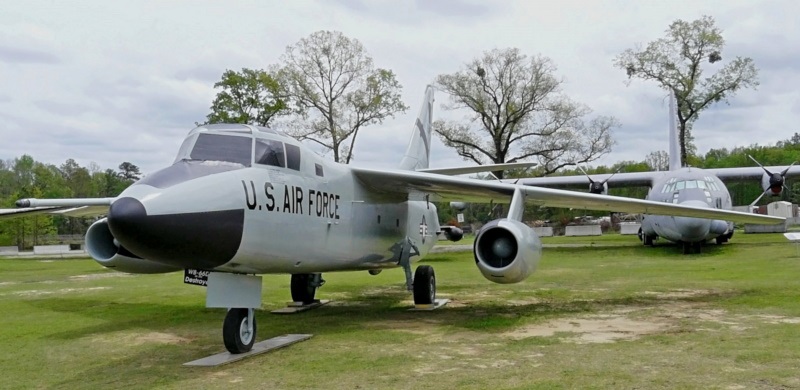
* Illustrations details:
* Revision history:
v1.0.0 / 01 aug 09 v1.0.1 / 01 nov 10 / Review & polish. v1.0.2 / 01 oct 12 / Review & polish. v1.0.3 / 01 sep 14 / Review & polish. v1.0.4 / 01 aug 16 / Review & polish. v1.0.5 / 01 jul 18 / Review & polish. v1.0.6 / 01 jun 20 / Illustrations update. v1.0.7 / 01 dec 21 / Review & polish. v1.0.8 / 01 oct 23 / Review & polish.BACK_TO_TOP
